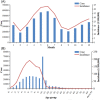Epidemiological features and sociodemographic factors associated with mumps in mainland China from 2004 to 2018
- PMID: 35739613
- PMCID: PMC9546204
- DOI: 10.1002/jmv.27955
Epidemiological features and sociodemographic factors associated with mumps in mainland China from 2004 to 2018
Abstract
Mumps is an acute infectious disease that spreads widely around the world. The aim of this study was to investigate the epidemiological features and sociodemographic factors associated with mumps in mainland China from 2004 to 2018. Incidence data for mumps during the period 2004-2018 were collected from the Public Health Sciences Data Center of China. Joinpoint regression analysis was performed to explore the trends of mumps. Space-time clustering analysis was conducted to spatial and temporal aggregation areas of mumps. A generalized linear model was used to explore sociodemographic factors associated with the incidence of mumps. The average annual incidence of mumps was 21.44/100 000 in mainland China. It was increased dramatically during 2004-2012 (annual percentage change [APC] = 7.51, 95% confidence interval [CI]: 2.28-13.00). After 2012, it remained stable, however, significantly increased in intermediately developed regions from 2015 to 2018 (APC = 25.84, 95% CI: 3.59-52.86). The first-level spatial and temporal aggregation areas were distributed in Xinjiang, Gansu, Qinghai, Ningxia and Shaanxi, Tibet, Sichuan, Yunnan, Chongqing, Guizhou, and Guangxi, with gathering times from January 1, 2006 to December 31, 2012 (relative risk [RR] = 1.87, p < 0.001). The percentage of the population aged 0-14 years, number of health workers per capital, and number of passengers were found to be positively associated with the incidence of mumps. Overall, after 2012, the incidence of mumps in mainland China remained stable. High-risk periods, clusters of regions, and sociodemographic factors for mumps were identified, which will help the government develop the disease- and location-specific interventive measures.
Keywords: epidemiology; mainland China; mumps; sociodemographic factors.
© 2022 The Authors. Journal of Medical Virology published by Wiley Periodicals LLC.
Conflict of interest statement
The authors declare no conflict of interest.
Figures




Similar articles
-
Epidemiological trends and sociodemographic factors associated with acute hemorrhagic conjunctivitis in mainland China from 2004 to 2018.Virol J. 2022 Mar 1;19(1):34. doi: 10.1186/s12985-022-01758-6. Virol J. 2022. PMID: 35232483 Free PMC article.
-
Epidemiological features and spatial-temporal distribution of visceral leishmaniasis in mainland China: a population-based surveillance study from 2004 to 2019.Parasit Vectors. 2021 Oct 7;14(1):517. doi: 10.1186/s13071-021-05002-y. Parasit Vectors. 2021. PMID: 34620225 Free PMC article.
-
Epidemiological Trends and Hotspots of Other Infectious Diarrhea (OID) in Mainland China: A Population-Based Surveillance Study From 2004 to 2017.Front Public Health. 2021 Jul 22;9:679853. doi: 10.3389/fpubh.2021.679853. eCollection 2021. Front Public Health. 2021. PMID: 34368054 Free PMC article.
-
Epidemiological trends of hepatitis C incidence and death in Mainland China between 2004 and 2018 and its predictions to 2030.BMC Infect Dis. 2025 Apr 8;25(1):483. doi: 10.1186/s12879-025-10881-y. BMC Infect Dis. 2025. PMID: 40200162 Free PMC article.
-
Epidemiology of alveolar echinococcosis with particular reference to China and Europe.Parasitology. 2003;127 Suppl:S87-107. Parasitology. 2003. PMID: 15027607 Review.
Cited by
-
Forecasting the Incidence of Mumps Based on the Baidu Index and Environmental Data in Yunnan, China: Deep Learning Model Study.J Med Internet Res. 2025 Feb 6;27:e66072. doi: 10.2196/66072. J Med Internet Res. 2025. PMID: 39913179 Free PMC article.
-
Mumps-specific antibody persistence in children aged 3-7 years immunized with two doses of mumps-containing vaccines: A prospective cohort study in Jiangsu Province, China.Hum Vaccin Immunother. 2023 Dec 31;19(1):2166758. doi: 10.1080/21645515.2023.2166758. Epub 2023 Jan 18. Hum Vaccin Immunother. 2023. PMID: 36653029 Free PMC article.
-
Age-period-cohort analysis and prediction of tuberculosis trends in China-based on the Global Burden of Disease 2021 data.Front Public Health. 2025 Feb 14;13:1512514. doi: 10.3389/fpubh.2025.1512514. eCollection 2025. Front Public Health. 2025. PMID: 40027502 Free PMC article.
-
Understanding Mumps Dynamics: Epidemiological Traits and Breakthrough Infections in the Population under 15 Years of Age in Jiangsu Province, China, 2023.Vaccines (Basel). 2024 Aug 29;12(9):986. doi: 10.3390/vaccines12090986. Vaccines (Basel). 2024. PMID: 39340017 Free PMC article.
-
Spatial Effect of Ecological Environmental Factors on Mumps in China during 2014-2018.Int J Environ Res Public Health. 2022 Nov 22;19(23):15429. doi: 10.3390/ijerph192315429. Int J Environ Res Public Health. 2022. PMID: 36497504 Free PMC article.
References
MeSH terms
LinkOut - more resources
Full Text Sources
Medical

